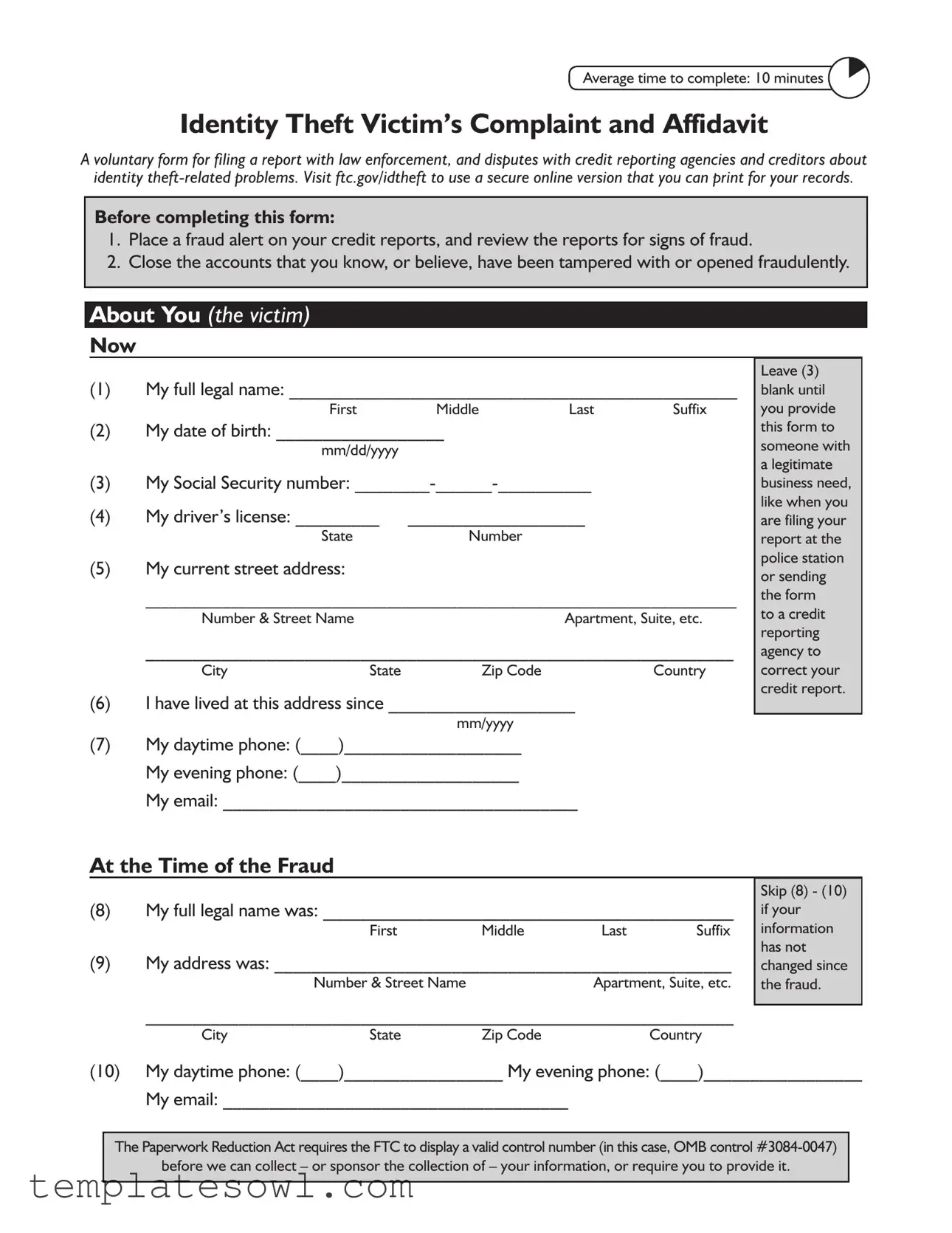Average time to complete: 10 minutes
Identity Theft Victim’s Complaint and Affidavit
A voluntary form for filing a report with law enforcement, and disputes with credit reporting agencies and creditors about identity theft-related problems. Visit ftc.gov/idtheft to use a secure online version that you can print for your records.
Before completing this form:
1.Place a fraud alert on your credit reports, and review the reports for signs of fraud.
2.Close the accounts that you know, or believe, have been tampered with or opened fraudulently.
About You (the victim)
Now
(1)My full legal name: ________________________________________________
(2)My date of birth: __________________
mm/dd/yyyy
(3)My Social Security number: ________-______-__________
(4) |
My driver’s license: _________ |
___________________ |
|
State |
Number |
(5)My current street address:
____________________________________________________________________________
Number & Street NameApartment, Suite, etc.
_______________________________________________________________
City |
State |
Zip Code |
Country |
(6)I have lived at this address since ____________________
mm/yyyy
(7)My daytime phone: (____)___________________
My evening phone: (____)___________________
My email: ______________________________________
Leave (3) blank until you provide this form to someone with
alegitimate business need, like when you are filing your report at the police station or sending the form
to a credit reporting agency to correct your credit report.
(8)My full legal name was: ____________________________________________
(9)My address was: _________________________________________________
Number & Street Name |
Apartment, Suite, etc. |
Skip (8) - (10) if your information has not changed since the fraud.
_______________________________________________________________
City |
State |
Zip Code |
Country |
(10)My daytime phone: (____)_________________ My evening phone: (____)_________________
My email: _____________________________________
The Paperwork Reduction Act requires the FTC to display a valid control number (in this case, OMB control #3084-0047)
before we can collect – or sponsor the collection of – your information, or require you to provide it.
Victim’s Name _______________________________ Phone number (____)_________________ Page 2
About You (the victim) (Continued)
Declarations
(11) |
I |
did |
OR |
did not |
authorize anyone to use my name or personal information to |
|
|
|
|
|
obtain money, credit, loans, goods, or services — or for any |
|
|
|
|
|
other purpose — as described in this report. |
(12) |
I |
did |
OR |
did not |
receive any money, goods, services, or other benefit as a |
|
|
|
|
|
result of the events described in this report. |
(13) |
I |
am |
OR |
am not |
willing to work with law enforcement if charges are brought |
|
|
|
|
|
against the person(s) who committed the fraud. |
About the Fraud
|
(14) I believe the following person used my information or identification |
(14): |
|
Enter what |
|
documents to open new accounts, use my existing accounts, or commit other |
you know |
|
fraud. |
|
|
|
about anyone |
|
|
|
|
|
you believe |
|
Name: ___________________________________________________ |
was involved |
|
(even if you |
|
First |
Middle |
Last |
Suffix |
|
don’t have |
|
|
|
|
|
|
Address: __________________________________________________ |
complete |
|
information). |
|
Number & Street Name |
Apartment, Suite, etc. |
|
|
__________________________________________________________ |
|
|
City |
State |
Zip Code |
Country |
|
Phone Numbers: (____)_______________ (____)________________
Additional information about this person: _____________________________________
_______________________________________________________________________
_______________________________________________________________________
_______________________________________________________________________
_______________________________________________________________________
_______________________________________________________________________
_______________________________________________________________________
_______________________________________________________________________
_______________________________________________________________________
_______________________________________________________________________
_______________________________________________________________________
Victim’s Name _______________________________ Phone number (____)_________________ Page 3
(15)Additional information about the crime (for example, how the identity thief gained access to your information or which documents or information were used):
________________________________________________________________
________________________________________________________________
________________________________________________________________
(14)and (15): Attach additional sheets as needed.
______________________________________________________________________________
______________________________________________________________________________
______________________________________________________________________________
______________________________________________________________________________
Documentation
(16)I can verify my identity with these documents:

 A valid government-issued photo identification card (for example, my driver’s license, state-issued ID card, or my passport).
A valid government-issued photo identification card (for example, my driver’s license, state-issued ID card, or my passport).
If you are under 16 and don’t have a photo-ID, a copy of your birth certificate or a copy of your official school record showing your enrollment and legal address is acceptable.

 Proof of residency during the time the disputed charges occurred, the loan was made, or the other event took place (for example, a copy of a rental/lease agreement in my name, a utility bill, or an insurance bill).
Proof of residency during the time the disputed charges occurred, the loan was made, or the other event took place (for example, a copy of a rental/lease agreement in my name, a utility bill, or an insurance bill).
(16): Reminder: Attach copies of your identity documents when sending this form to creditors
and credit reporting agencies.
About the Information or Accounts
(17)The following personal information (like my name, address, Social Security number, or date of birth) in my credit report is inaccurate as a result of this identity theft:
(A)__________________________________________________________________________
(B)__________________________________________________________________________
(C)__________________________________________________________________________
(18)Credit inquiries from these companies appear on my credit report as a result of this identity theft:
Company Name: _______________________________________________________________
Company Name: _______________________________________________________________
Company Name: _______________________________________________________________
Victim’s Name _______________________________ Phone number (____)_________________ Page 4
(19)Below are details about the different frauds committed using my personal information.
___________________________________________________________________
Name of InstitutionContact Person Phone Extension
___________________________________________________________________
|
|
|
|
|
|
|
Account Number |
|
Routing Number |
Affected Check Number(s) |
Account Type: |
Credit |
Bank |
Phone/Utilities |
Loan |
|
|
Government Benefits |
Internet or Email |
Other |
Select ONE:

 This account was opened fraudulently.
This account was opened fraudulently.

 This was an existing account that someone tampered with.
This was an existing account that someone tampered with.
___________________________________________________________________
Date Opened or Misused (mm/yyyy) Date Discovered (mm/yyyy) Total Amount Obtained ($)
___________________________________________________________________
Name of InstitutionContact Person Phone Extension
___________________________________________________________________
|
|
|
|
|
|
|
Account Number |
|
Routing Number |
Affected Check Number(s) |
Account Type: |
Credit |
Bank |
Phone/Utilities |
Loan |
|
|
Government Benefits |
Internet or Email |
Other |
Select ONE:

 This account was opened fraudulently.
This account was opened fraudulently.

 This was an existing account that someone tampered with.
This was an existing account that someone tampered with.
___________________________________________________________________
Date Opened or Misused (mm/yyyy) Date Discovered (mm/yyyy) Total Amount Obtained ($)
___________________________________________________________________
Name of InstitutionContact Person Phone Extension
___________________________________________________________________
|
|
|
|
|
|
|
Account Number |
|
Routing Number |
Affected Check Number(s) |
Account Type: |
Credit |
Bank |
Phone/Utilities |
Loan |
|
|
Government Benefits |
Internet or Email |
Other |
Select ONE:

 This account was opened fraudulently.
This account was opened fraudulently.

 This was an existing account that someone tampered with.
This was an existing account that someone tampered with.
___________________________________________________________________
Date Opened or Misused (mm/yyyy) Date Discovered (mm/yyyy) Total Amount Obtained ($)
(19):
If there were more than three frauds, copy this page blank, and attach as many additional copies as necessary.
Enter any applicable information that you have, even if it is incomplete or an estimate.
If the thief committed two types of fraud at one company, list the company twice, giving the information about the two frauds separately.
Contact Person: Someone you dealt with, whom an investigator can call about this fraud.
Account Number: The number of the credit or debit card, bank account, loan, or other account that was misused.
Dates: Indicate when the thief began to misuse your information and when you discovered the problem.
Amount Obtained: For instance, the total amount purchased with the card or withdrawn from the account.
Victim’s Name _______________________________ Phone number (____)_________________ Page 5
Your Law Enforcement Report
(20)One way to get a credit reporting agency to quickly block identity theft- related information from appearing on your credit report is to submit a detailed law enforcement report (“Identity Theft Report”). You can obtain an Identity Theft Report by taking this form to your local law enforcement office, along with your supporting documentation. Ask an officer to witness your signature and complete the rest of the information in this section. It’s important to get your report number, whether or not you are able to file in person or get a copy of the official law enforcement report. Attach a copy of any confirmation letter or official law enforcement report you receive when sending this form to credit reporting agencies.
Select ONE:

 I have not filed a law enforcement report.
I have not filed a law enforcement report.

 I was unable to file any law enforcement report.
I was unable to file any law enforcement report.

 I filed an automated report with the law enforcement agency listed below.
I filed an automated report with the law enforcement agency listed below.

 I filed my report in person with the law enforcement officer and agency listed below.
I filed my report in person with the law enforcement officer and agency listed below.
____________________________________________________________________
Law Enforcement DepartmentState
____________________________ |
_____________________ |
Report Number |
Filing Date (mm/dd/yyyy) |
(20):
Check “I have not...” if you have not yet filed a report with law enforcement or you have chosen not to. Check “I was unable...” if you tried to file a report but law enforcement refused to take it.
Automated report:
Alaw enforcement report filed through an automated system, for example, by telephone, mail, or the Internet, instead of a face-to-face interview with a law enforcement officer.
____________________________________________________________________
Officer’s Name (please print)Officer’s Signature
____________________________ |
(____)_______________ |
|
|
Badge Number |
Phone Number |
|
|
Did the victim receive a copy of the report from the law enforcement officer? |
Yes OR |
No |
Victim’s FTC complaint number (if available): ________________________ |
|
|
Victim’s Name _______________________________ Phone number (____)_________________ Page 6
Signature
As applicable, sign and date IN THE PRESENCE OF a law enforcement officer, a notary, or a witness.
(21)I certify that, to the best of my knowledge and belief, all of the information on and attached to this complaint is true, correct, and complete and made in good faith. I understand that this complaint or the information it contains may be made available to federal, state, and/or local law enforcement agencies for such action within their jurisdiction as they deem appropriate. I understand that knowingly making any false or fraudulent statement or representation to the government may violate federal, state, or local criminal statutes, and may result in a fine, imprisonment, or both.
_______________________________________ |
_________________________________________ |
Signature |
Date Signed (mm/dd/yyyy) |
Your Affidavit
(22)If you do not choose to file a report with law enforcement, you may use this form as an Identity Theft Affidavit to prove to each of the companies where the thief misused your information that you are not responsible for the fraud. While many companies accept this affidavit, others require that you submit different forms. Check with each company to see if it accepts this form. You should also check to see if it requires notarization. If so, sign in the presence of a notary. If it does not, please have one witness (non-relative) sign that you completed and signed this Affidavit.
_______________________________________
Notary
Witness:
_______________________________________ |
_________________________________________ |
Signature |
Printed Name |
_______________________________________ |
_________________________________________ |
Date |
Telephone Number |





 A valid
A valid 
 Proof of residency during the time the disputed charges occurred, the loan was made, or the other event took place (for example, a copy of a rental/lease agreement in my name, a utility bill, or an insurance bill).
Proof of residency during the time the disputed charges occurred, the loan was made, or the other event took place (for example, a copy of a rental/lease agreement in my name, a utility bill, or an insurance bill).

 This account was opened fraudulently.
This account was opened fraudulently.
 This was an existing account that someone tampered with.
This was an existing account that someone tampered with.
 This account was opened fraudulently.
This account was opened fraudulently.
 This was an existing account that someone tampered with.
This was an existing account that someone tampered with.
 This account was opened fraudulently.
This account was opened fraudulently.
 This was an existing account that someone tampered with.
This was an existing account that someone tampered with.

 I have not filed a law enforcement report.
I have not filed a law enforcement report.
 I was unable to file any law enforcement report.
I was unable to file any law enforcement report.
 I filed an automated report with the law enforcement agency listed below.
I filed an automated report with the law enforcement agency listed below.
 I filed my report in person with the law enforcement officer and agency listed below.
I filed my report in person with the law enforcement officer and agency listed below.